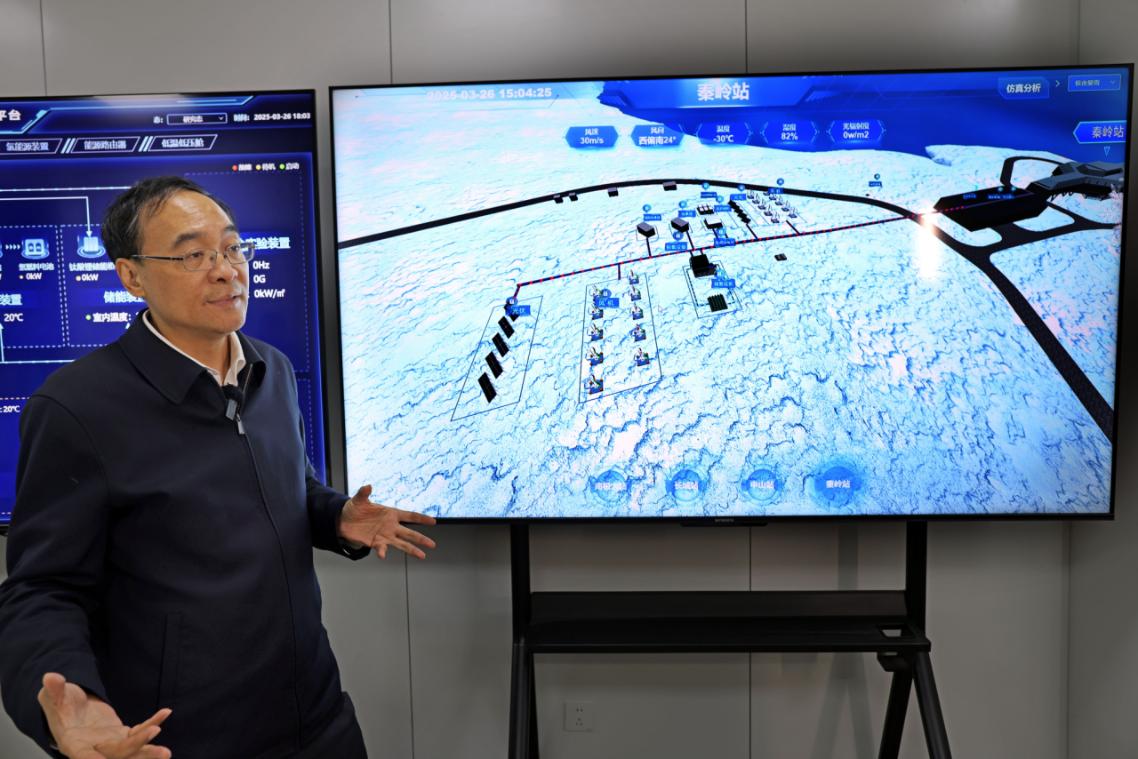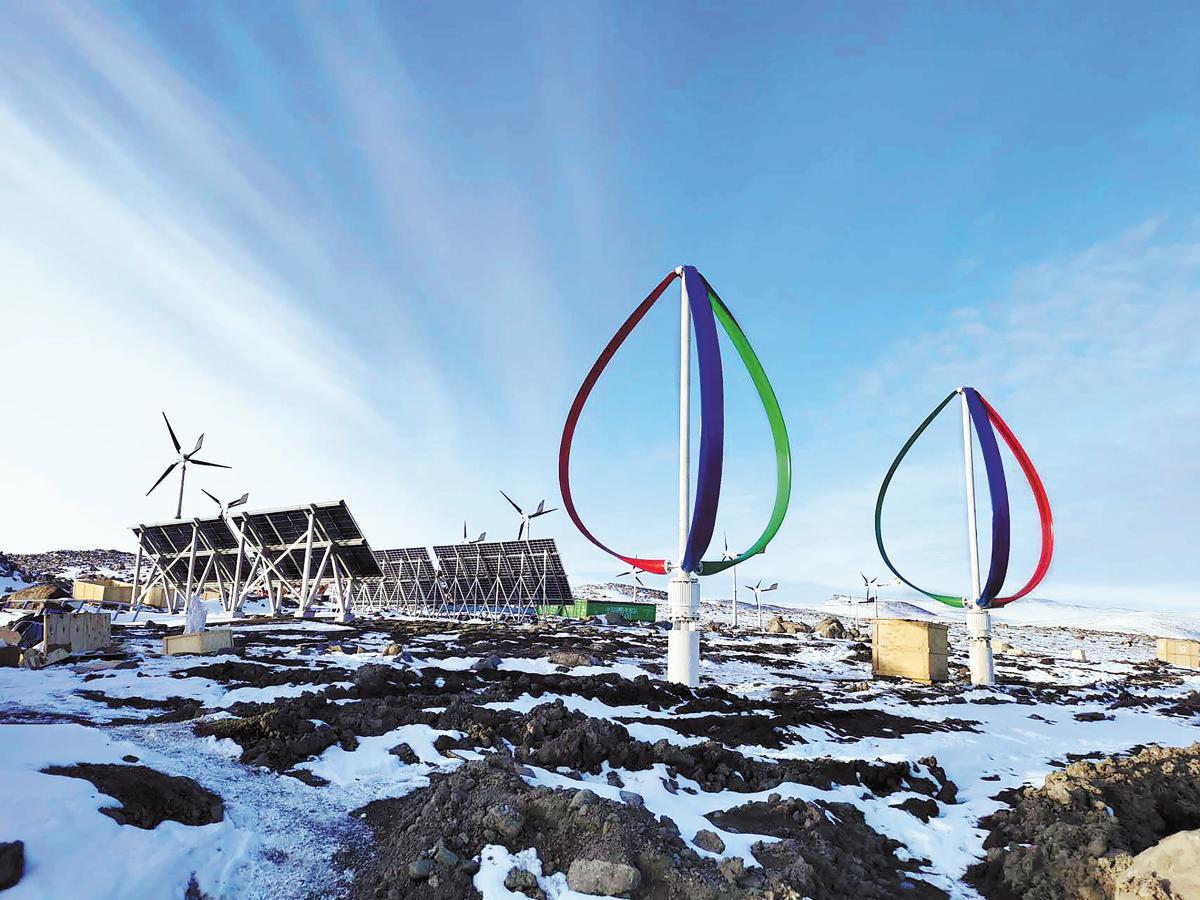
一套专为极地环境定制的清洁能源系统已在中国南极秦岭站投入运行。
这一突破意味着中国成为首个在南极极端环境下实现规模化新能源系统运行的国家。
56岁的首席科学家孙宏斌告诉《中国日报》,该项目标志着中国取得了极地能源领域绿色科学探索的里程碑,也意味着我国极地科考从“柴油时代”迈入了绿色能源新时代。
“该系统启用将产生大量数据,同时带来诸多挑战,推动持续性研究。”孙宏斌说。他是中国极地研究中心极地清洁能源首席科学家,同时也是山西省人大代表、太原理工大学校长。
自3月1日系统启动以来,它已取代传统柴油动力源,为2024年2月建成的中国第五个南极科考站——秦岭站的科研设备和基本生活设施提供持续零碳电力。
在该系统的能源构成中,光伏和风电占整个站区总能源容量的60%。在无风和无日照等极端天气下,储存的氢气可为科考站供电,保障科研设备和基础生活设施的短期运行。
孙宏斌强调,确保设备可靠性和系统安全性是主要挑战。例如,研发能够在冰盖上运行的“水滴形”风力发电机,以及氢燃料电池所需的耐寒冷启动技术。
南极秦岭站新能源系统建设项目始于2023年。

3月26日,太原理工大学校长孙宏斌在该校极地环境清洁能源实验室内介绍秦岭站清洁能源系统。 朱兴鑫 摄
由于大部分设备和设施需专门研发改造以适应极端环境,太原理工大学建立了模拟南极环境的数字孪生实验室。
该实验室可模拟近10种极端条件,包括极寒、强风、暴雪、极昼极夜、强地磁、强紫外线辐射、低压和低氧环境等。
孙宏斌表示,建立实验室的主要初衷是应对研究、测试和运行中的挑战。
“设备一旦抵达南极,哪怕一颗螺丝钉坏了都没有地方买。”他说,“在运往南极之前,各类新能源装置都在此进行测试。如今,实验室还接收并分析从南极传回的实时数据。”
近年来,世界各国围绕南极清洁能源发展进行探索,主要聚焦太阳能和风能。但极端环境与技术短板使风光发电设备难以稳定高效运行。
“中国是首个在南极极端环境中规模化应用氢能的国家。”太原理工大学电气与动力工程学院院长窦银科说。自2004年起,窦银科多次参与南极科考,是该领域权威专家。
窦银科表示,在全球变暖和冰川消融背景下,中国于2017年提出“绿色科考”的倡议。国际相关组织多次建议各国在南极从燃油发电转向清洁能源,但受极地环境恶劣制约,进展缓慢。
南极拥有巨大的风能和太阳能潜力,目前全球约30个南极科考站已安装清洁能源发电设备,半数以上采用太阳能或风能。
然而,他补充说,由于缺乏针对南极环境特点的清洁能源技术系统性应用与开发,在安全性和稳定性上仍无法完全取代传统能源系统。
“当前全球80%至90%的南极科考站仍依赖燃油发电,给极地造成了严重的环境污染。”窦银科说。
2024年,太原理工大学牵头编制的《南极清洁能源利用技术十二年发展纲要》发布,目标是到2035年形成完备的南极科考站清洁能源供给技术体系。
“我这辈子就做这件事。这只是万里长征的第一步,是一次示范和实验。”孙宏斌说。他表示,关键技术突破还将推动中国重要能源基地山西省的能源革命。
孙宏斌希望在山西建立一个两万平方米的南极极端环境模拟实验室,以加强未来的研究工作。
“有了清洁能源,人在极地就能存活下去。未来,我们甚至可能在月球和火星上安装和测试这项技术。”他说。
(中国日报山西记者站首席记者 朱兴鑫)
英文原文:

Two droplet-shaped wind turbines spin in front of China's Qinling station in Antarctica. CHINA DAILY
A clean energy system tailored for polar conditions has been put into operation in China's Qinling station in Antarctica.
The breakthrough means China has become the first country to achieve the large-scale operation of a clean energy system under extreme Antarctic conditions.
Lead scientist Sun Hongbin, 56, told China Daily that the project marks an achievement in China's green scientific exploration in the field of polar energy, and signifies that the nation's polar exploration has developed from the diesel era into a new era of green energy.
The system will generate a wealth of data, as well as present challenges that will prompt continuous research, said Sun, who is also the chief scientist on polar clean energy at the Polar Research Institute of China and president of Taiyuan University of Technology in Shanxi province.
Since the launch of the system on March 1, it has replaced traditional diesel power sources, providing uninterrupted zero-carbon power for the research equipment and essential living facilities at Qinling station, which was established in February last year as China's fifth Antarctic research station.
Photovoltaic and wind power account for 60 percent of the energy capacity of the system. In situations without wind or sunlight, stored hydrogen can provide power to the station, ensuring short-term operation for research equipment and basic living facilities.
Sun stressed the primary challenges in ensuring the reliability and safety of the equipment. For instance, the development of the droplet-shaped wind turbine capable of operating on ice caps and hydrogen fuel cells demands cold-resistant power-up technology.
Construction of the system at the station commenced in 2023.
As much of the equipment and facilities required specialized research and modification to adapt to the extreme conditions, Taiyuan University of Technology established a digital twin laboratory simulating the environment of Antarctica.
This laboratory possesses the capabilities to simulate nearly 10 extreme conditions, including extreme cold, strong winds, blizzards, polar day and night, intense geomagnetic fields, strong ultraviolet radiation, low pressure and low oxygen levels.
The primary purpose of establishing this laboratory was to address the challenges of research, testing and operation, Sun said.
"Once the equipment arrives in Antarctica, we have no means to procure a replacement if a single screw malfunctions," he said. "Before deployment to Antarctica, various new energy devices underwent testing here. Now the laboratory receives and analyzes real-time data transmitted back from Antarctica."
In recent years, various countries have explored approaches to develop clean energy in Antarctica, with solar and wind energy being the primary focus.
However, the extreme conditions and shortage of technologies make it tough for solar and wind power generation equipment to maintain stable and efficient operation.

Sun Hongbin introduces the clean energy system for Qinling station
in Antarctica at Taiyuan University of Technology in Shanxi province. ZHU XINGXIN/CHINA DAILY
China is the first country to implement hydrogen energy in the extreme environment of Antarctica on a large scale, said Dou Yinke, dean of the Taiyuan university's College of Electrical and Power Engineering, and a leading expert who has participated in multiple Antarctic expeditions since 2004.
Against the backdrop of global warming and glacier melting, China proposed the concept of "green exploration" in 2017, Dou said. International organizations have repeatedly urged countries to transition from fuel-based power generation to clean energy in Antarctica.
As Antarctica possesses vast wind and solar energy potential, countries worldwide have been exploring clean energy in this area.
To date, approximately 30 Antarctic research stations have installed clean energy generation devices, with over half utilizing solar or wind, Dou said.
However, due to the lack of systematic application and development of clean energy technologies tailored to the Antarctic environment, these systems cannot yet fully replace traditional energy systems on the aspects of safety and stability, he said.
Currently, 80 to 90 percent of the world's Antarctic research stations still rely on fuel-powered electricity generation, leading to significant environmental pollution in the polar regions, said Dou.
Last year, the Taiyuan university led the formulation of the "Twelve-Year Development Outline for Clean Energy Utilization Technologies in the Antarctic", aiming to establish a comprehensive clean energy supply system for Antarctic research stations by 2035.
"I will dedicate my whole life to the cause. I believe we have just taken the first step on a long journey. It is a demonstration and an experiment," Sun said. Key technology breakthroughs can also drive the energy revolution in the province, a major energy base in China, said Sun.
Sun hopes to establish a 20,000-square-meter Antarctic extreme environment simulation laboratory in Shanxi to enhance future research.
"With clean energy, people can survive in polar regions. In the future, we may even install and test this technology on the moon and Mars," Sun said.
来源:中国日报,2025年4月22日第7版
链接:
1. https://sx.chinadaily.com.cn/a/202504/22/WS68070bffa310e29a7c4aa96a.html
2. https://www.chinadaily.com.cn/a/202504/22/WS6806ea30a3104d9fd3820bb6_1.html